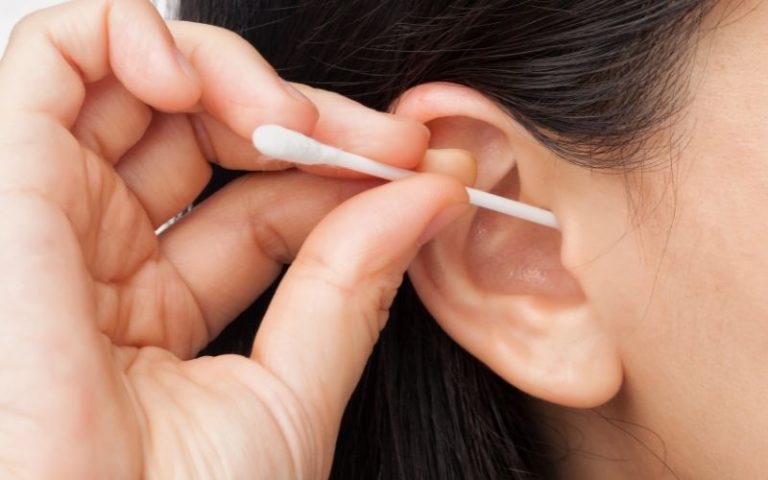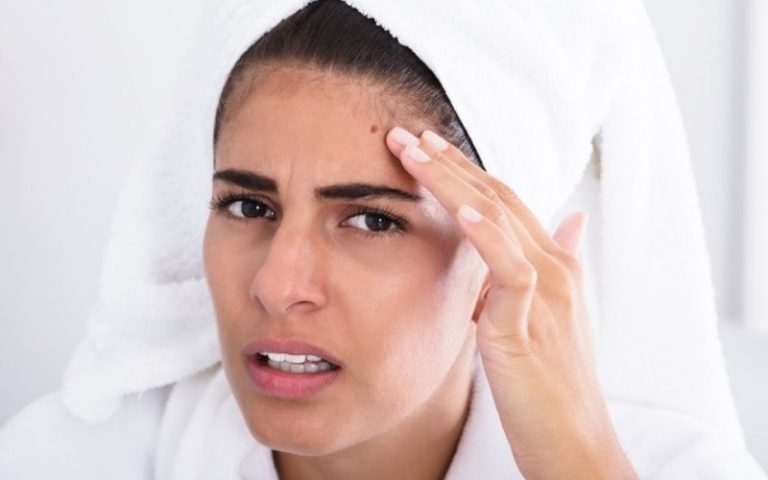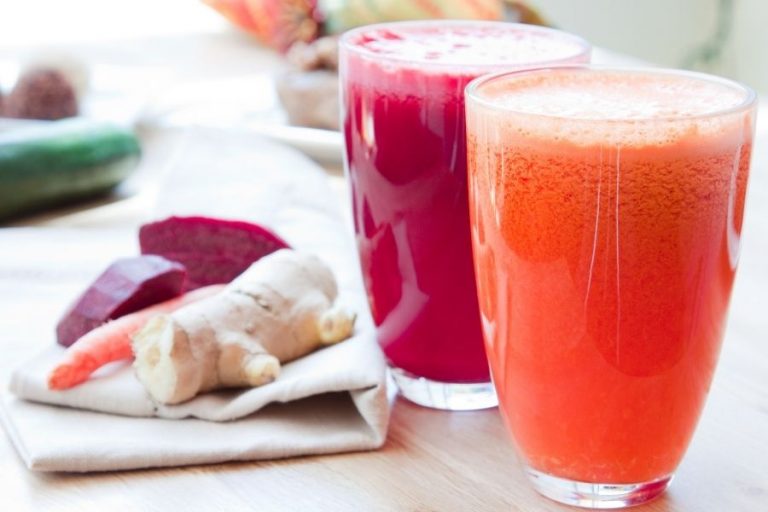Acne Around The Mouth Might Mean Your Hormones Are Crying For Help

When you think of acne, what comes to mind?
For us, it’s bumps that make us feel embarrassed that — without fail, pop up overnight on our face the morning of a big event.
What perfect timing! Not.
Acne is a skin condition we all face, but what many don’t expect is to get a pimple or breakout around the mouth.
Let’s look into this:
Bumps are common on the jawline but can appear around the mouth area causing inflammation, redness, and dryness that only gets worse as the day goes on, since the mouth is an area constantly coming into contact with other things.
Even worse, figuring out the cause can be difficult since a lip pimple can occur for many reasons.
What we do know is they typically stem from activities that create pressure around the mouth.
Regardless of the cause of acne and skin irritation, you can achieve clear skin with any skin type by incorporating a few changes to your skincare routine and say bye bye to those bumps!
How to directly treat
Okay, given this might be an emergency, let’s get right into some treatments.
Topicals
Besides lifestyle changes to prevent acne around the mouth, the best way to fight any active breakout you have is directly with daily care products available over-the-counter and/or prescriptions from your dermatologist or doctor.
Natural remedies
Whether you’re looking to go the natural route, or just don’t have any fancy products, we got you covered. There are plenty of natural ingredients that can soothe acne that might just be in your kitchen! These include:
- Aloe vera: Aloe has anti-inflammatory properties that reduce redness.
- Turmeric: Either fresh or powder, turmeric is a powerful antioxidant that can be applied to acne and make them far less angry-looking.
- Strawberry: Did you know strawberry contains the same salicylic acid that’s commonly use to fight pimples? Try out our strawberry DIY facial mask.
- Honey: Honey is known to have anti-bacterial properties and can reduce swelling.
- Oats/Oat milk: Oats are commonly used as soothing agents to calm down any areas that have inflammation.
Salicylic acid
Salicylic acid is one of the most common ingredients found in over-the-counter acne products.
It comes in face washes, toners, and serums.
Salicylic acid is a BHA, or beta hydroxy acid, that has been the go-to acne fighting ingredient for decades.
It chemically exfoliates the skin by targeting the excess sebum, or oil, in pores.
Benzoyl peroxide
Benzoyl Peroxide is a strong over the counter ingredient that’s antiseptic and fights germs.
You can use a cleanser with a benzoyl peroxide at night. Be sure to follow with a good moisturizer.
There are spot treatments with benzoyl peroxide that can be used on pimples.
If you find your skin gets too irritated from leaving it on overnight, you can leave it on for 10-20 minutes as you would a mask, and rinse it off.
Retinoids are a strong topical treatment and one of the best ways to combat not only adult acne, but aging.
You can buy over-the-counter retinol serums or get a prescription from your doctor.
It should be noted that too strong of a retinoid can be an irritant around the mouth area and should be used with caution.
Exfoliate
Be sure to get rid of that dead skin! Exfoliation is when you help rid the top layer of your skin of excess dead skin cells and oil.
It’s important to exfoliate as this helps shed skin, promote new growth, and get rid of acne.
You should exfoliate a couple times a week depending on how well your skin handles it.
You can buy a physical exfoliant or scrub, which is a face wash with microbeads that cause friction to help shed the dead skin cells and break up excess oil.
Chemical exfoliants are another option. Look for ingredients such as lactic acid, glycolic acid, and salicylic acid.
They are found in face washes, toners, and chemical peels or masks.
Why am I getting this
You might be wondering why the heck these lip pimples are happening in the first place, we’ll explain.
Your mouth area touches many things
One reason may be that the skin near the lip area is a prime spot to come into contact with things more often than the rest of the face, whether by your own fingers or something else which can clog the pores.
Do you wear headgear?
One type of external source of touch and friction that can cause inflammation of the lip area is wearing something with a chin strap.
Helmets and other headgear that touches your face can cause sweat and oil gland build up leading to clogged pores under the area being covered.
Facial hair and shaving
Oils, creams, shaving lotions, and lip balms can also cause pimples around the mouth area, too.
The act of shaving the hair on your face can be irritating if you have sensitive skin.
Hair follicles on the beard or mustache are susceptible to getting clogged and forming pimples.
Other possible causes
Musical instruments that touch the lip and mouth can also harbor the bacteria that cause acne.
Likewise, cell phones placed near your mouth can cause bacteria buildup and lead to pimples as well.
Role of hormones in acne around the mouth
As if hormones in general weren’t already a nuisance, they sure like to mess with our skin health, too.
Hormones are a culprit of acne everywhere on the body and often lead to cystic acne.
Androgens are the hormone responsible for sebum production which in excess can lead to clogged pores and hormonal acne.
When our hormones are going crazy, that means our skin probably will as well.
Both female and male hormones can cause a hormonal imbalance of estrogen, progesterone, and testosterone throughout adulthood.
Hormonal acne typically appears on the jawline and chin and can lead to whiteheads or in severe cases, cystic acne which are large and painful pustules or cysts.
Common hormonal imbalances happen during puberty, menstruation, menopause, pregnancy, side effects from birth control pills, and hormonal disorders such as PCOS.
These hormone changes unfortunately manifest on the surface of the skin. Errgh.
The facts
Before we get specific, let’s talk about the basics.
Acne, or p. acnes bacteria, is caused from an excess buildup of oil production in the sebaceous glands.
When there’s so much oil production in the sebaceous glands, it is much more likely to clog pores and develop acne breakouts.
The most common places to see breakouts on the face is the t-zone. This includes your forehead, nose, and down to your chin.
Sound familiar?
Types of acne around the mouth
We’ve all seen different types of pimples.
From big to small, oozy to smooth, zits to scabs, pimples occur in various forms whenever they appear.
We want to give you some clues as to which skin issues you may be experiencing to help you determine an acne treatment for those pesky pimples.
- Blackheads: Tiny bumps that form from the overproduction of sebum in the hair follicle. The surface appears dark or black. They are considered one of the more mild types of acne breakouts.
- Whiteheads: Closed comedones that are tiny with a white head full of pus, or excess oil.
- Cystic acne: A more severe type of acne often caused by hormonal changes. Sometimes referred to as nodules, lesions, or papules, cysts go deeper beneath the skin’s surface.
- Cold sores: A type of rash that also appear around the mouth and can be confused with pimples. A cold sore may itch and feel like dry skin.
Acne around the mouth prevention:
Pimples around the lip area can feel embarrassing and painful, but with a few lifestyle changes you can beat them.
Keep your mouth area clean
Along with excess oil production, excess bacteria also leads to acne.
It’s important to always clean the chin area and lip area after using toothpaste and eating or drinking.
These can also lead to cold sores and worsen any inflammation even if it’s not a pimple.
When you brush your teeth, be sure to always rinse and wipe off any toothpaste.
The ingredients that fight plaque in toothpaste such as fluoride and the alcohol in mouthwash can be abrasive to the sensitive skin around the lip and lead to pimples and bumps.
This is an easy thing to forget to do but important to add to your routine.
You can be sure to keep the mouth area clean by wiping with a gentle baby wipe or clean napkin after eating or drinking.
Rinsing with warm water also helps ensure you remove any leftover plaque and residue from inside the mouth.
Beware of certain lip products
We all have our favorite lip balm that we love, but what if our skin doesn’t feel the same way?
Another trigger for acne is contact dermatitis.
This can happen from products containing ingredients to which we are sensitive.
This greatly depends on the individual since some people’s skin is more sensitive to certain ingredients than others.
If you notice an onset of pimples around the lip area, look at what lip balm, lipstick, and other cosmetic products you’re using.
Chances are, if you’ve recently started using a new skin care product, the culprit is a new ingredient you’re not used to.
There are several common non-comedogenic (or pore-clogging) ingredients found in ointments, lip balms, lipsticks and chapsticks.
The main ones known to cause an allergic reaction are oils (such as coconut oil), different types of wax, and cocoa butter.
If you aren’t sensitive to any ingredients, then it’s also possible that your chapstick or lip balm is causing you to break out because you’re applying too much to the skin and clogging the pores or facial hair follicle.
Be sure to only apply your chapstick to the lip line and avoid using too much!
Adopt a good cleansing routine
Wash your face well… and regularly.
Cleansing the face properly of any gunk and residue that can clog the oil glands every night is an important part of anyone’s skin care routine.
Just because you don’t wear makeup doesn’t mean you can skip washing your face.
It’s important to wash the skin’s surface with a cleanser that thoroughly breaks up excess sebum to control breakouts.
Look for acne-fighting ingredients
Besides making sure to wash your face with a cleanser, it’s important to choose one with acne-fighting ingredients.
Look for a cleanser with salicylic acid or benzoyl peroxide.
Salicylic acid is a beta hydroxy acid that is oil-soluble, meaning it hits oil right at the source to break it up.
Benzoyl peroxide is an antibacterial ingredient found in face washes and spot treatments that can be very drying but also very powerful.
If using a benzoyl peroxide face wash, wash once daily and be sure to follow up with a good moisturizer.
Find a quality moisturizer
Just because you’re trying to fight excess oil production doesn’t mean you shouldn’t still keep your skin moisturized!
Drying out your skin with cleansers is often the culprit for excess oil production, as your skin is trying to replaneish the oil that’s been stripped.
Adding a quality moisturizer to your routine will take the heavy load off your oil glands.
For a good moisturizer, look for one that’s oil-free or marketed towards acne-prone skin.
Sometimes called “SLS,” sodium laureth sulfates are found in many face and hair products such as face wash and shampoo as a foaming agent to clean.
They are especially good for oily skin; however for sensitive skin, they can clog the pores and cause inflammation leading to more acne.
Change/wash face masks often
A newer cause and contributor to acne around the mouth is face masks.
Wearing a mask all day creates a humid environment full of moisture that’s ripe for harboring bacteria on the jawline and cheek.
This leads not just to breakouts but can cause a rash as well!
It’s important to sanitize the fabric of your face mask and wash it after each use if you are using a reusable one.
Keep the area as dry as possible throughout the day and consider using an antibacterial wipe.
Remember when wearing face masks to remove any food or drink from the mouth area before putting it back on.
Diet!
Our diet affects so many functions of our body, especially the skin!
Many foods are known to contribute to acne.
If you have certain trigger foods then it’s important to avoid them during a particularly bad flare-up.
If you aren’t sure if you’re sensitive to certain acne-causing foods, then think about removing some of the most well-known ones from your diet to see if your acne improves.
Dairy, gluten, chocolate, and caffeine are the 4 big-hitters that have been suggested to trigger acne.
Just as it’s important to avoid foods that may trigger acne, it’s also important to incorporate foods rich in vitamins and minerals that will help fight it.
Eat a rainbow of colors when it comes to choosing your fruits and vegetables.
This ensures you’re getting a wide range of vitamins and minerals in your diet, which is a pretty kick-ass combo when it comes to fighting acne.
Seek help from a dermatologist
There’s no shame in waving the white flag in your DIY search for skin solutions.
Seek help from a pro.
If you feel you have exhausted all of your options or want a professional opinion, visit your dermatologist for a proper diagnosis.
A doctor will also be able to prescribe you topicals at higher concentrations approved by the FDA drug administration than over-the-counter products.
In some cases a doctor may recommend prescription treatments such as oral antibiotics, topical steroids, or topical antibiotics.
Isotretinoin, also known as Accutane, is a strong treatment plan that can be prescribed in severe cases.
You may need to see an M.D. outside of the realm of dermatology to discuss options for treating your hormones.
A common oral medication used to treat hormonal imbalances is spironolactone.
Certain oral contraceptives such as ortho tri-cyclen may be prescribed for women as a treatment to combat hormonal imbalances as well.
A doctor will also be able to diagnose if the acne around your mouth is being caused by allergies and can advise you on which ingredients to look for and to avoid.
An M.D. will be able to help you with the best treatment plan.
Conclusion
Acne around the mouth can be painful and tough to deal with, but just like pimples anywhere else, finding the right skincare regime will improve it tremendously!
It may seem overwhelming, but choose a few tips here to incorporate and see if your acne improves.
Chances are for mild cases you only need to make sure you wash your face more often and apply a topical treatment to your lip pimples.
If you still get zits, don’t worry!
Schedule an appointment with your dermatologist for professional advice.
Incorporating acne fighting ingredients are important, but it’s also just as important to be sure you’re not eating anything that’s contributing to acne.
Be sure to properly hydrate and consume a wide range of whole foods.
The combination of fighting your zits with a new skin care product and adjusting your diet may be the best skin routine for you, and your overall health will thank you in the long run!
At the end of the day the best treatment is the one that works for you.
- “Acne.” National Institutes of Health, 2016, niams.nih.gov/health-topics/acne
- “Acne.” Women’s Health, 2018, womenshealth.gov/a-z-topics/acne
- Bienenfeld A, et al. Androgens in women: Androgen-mediated skin disease and patient evaluation Journal of the American Academy of Dermatology, 2019, 10.1016/j.jaad.2018.08.062
- Elsaie ML. “Hormonal treatment of acne vulgaris: An update,” 2016 10.2147/CCID.S114830
- “Red rash around your mouth could be perioral dermatitis,” American Academy of Dermatology Association, aad.org/public/diseases/rashes/perioral-dermatitis





